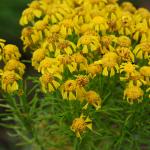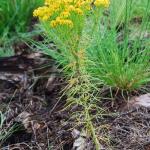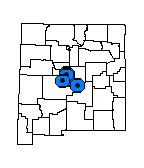Hymenoxys brachyactis (Tall Bitterweed)
Family
ASTERACEAE
Synonyms
NONE
Common Name
Tall Bitterweed
| USFWS | State of NM | USFS | BLM | Navajo Nation | State Rank | Global Rank | R-E-D Code | NMRPTC Status | Strategy Status |
|---|---|---|---|---|---|---|---|---|---|
| SEN | S3 | G3 | 1-1-3 | R | SS |
| Overall Conservation Status | Documented Threats | Actions Needed |
|---|---|---|
| UNDER CONSERVED | No Information |
Status surveys on abundance and distribution; study effects of fires. |
Description
Biennial herb; stem solitary, branching above the middle, 3-6 dm tall, glabrous or sparsely pubescent in the inflorescence; basal rosette leaves dying when the plant flowers; stem leaves numerous, pinnatifid with narrowly linear lobes; inflorescence corymbose (flat-topped); involucre of flower heads 5-8 mm tall, outer phyllaries united for 1/3 to 1/2 their length, inner phyllaries ciliate-margined and blunt to acute at the apex; flowers yellow, ray corollas usually shorter than the length of the involucre; achenes appressed-hairy, pappus scales acute to acuminate at the apex. Flowers late July to September.
Similar Species
Hymenoxys richardsonii is a strong perennial with more than one stem. Hymenoxys vaseyi is usually perennial with one or more stems, has ray corollas as long or longer than the involucre, outer phyllaries united for 1/2 to 2/3 their length, and pappus scales blunt at the apex.
Distribution
New Mexico, northwestern Lincoln, northeastern Socorro, and western Torrance counties, southern Manzano Mountains, Gallinas Mountains, Los Pinos Mountains, and northern Chupadera Mesa.
Habitat
Dry sites with coarse soils in piñon-juniper woodland and lower montane coniferous forest; 2,100-2,500 m (6,900-8,200 ft).
Remarks
This New Mexico endemic was considered a synonym of Hymenoxys vaseyi for many decades. Now that additional field collections are available, the differences between the two taxa become more obvious and support the separation of these two species. The tall, single stem and monocarpic habit (flowers once - then dies) of H. brachyactis are especially diagnostic.
Conservation Considerations
This narrow endemic is locally abundant and will sometimes occupy disturbed sites. The prevailing land uses within its habitats do not threaten this species.
Important Literature
Wooton, E.O. and P.C. Standley. 1913. Descriptions of new plants preliminary to a report upon the flora of New Mexico. Contributions from the U.S. National Herbarium 16:109-196.
Information Compiled By
Robert Sivinski 1999
For distribution maps and more information, visit Natural Heritage New Mexico





